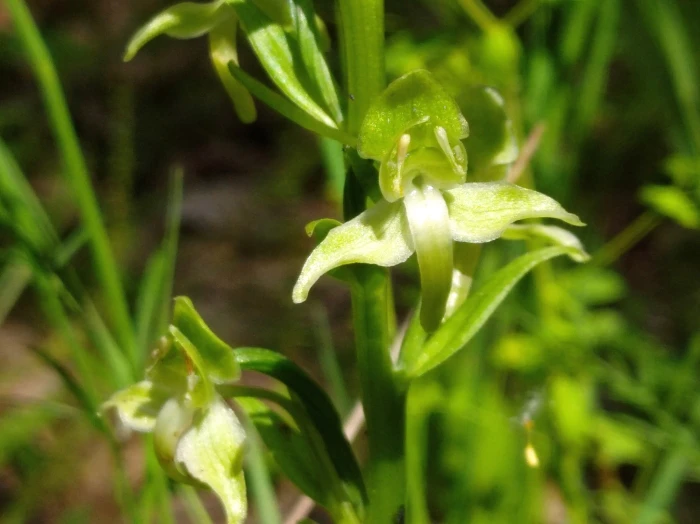Greater Butterfly-Orchid
(Platanthera chlorantha)
Greater Butterfly-Orchid (Platanthera chlorantha)
/
/

katunchik
CC BY 4.0
Image By:
katunchik
Recorded By:
Copyright:
CC BY 4.0
Copyright Notice:
Photo by: katunchik | License Type: CC BY 4.0 | License URL: http://creativecommons.org/licenses/by/4.0/ | Rights Holder: katunchik | Publisher: iNaturalist | Date Created: 2021-05-27T10:28:24-07:00 |





















Estimated Native Range
Climate Requirements for Kakogawachō-honmachi, Japan
| This Plant | Your Site | Plant Suitability for Your Location | ||
|---|---|---|---|---|
| • Precipitation | 4" - 142" | 54" | Aquatic | Aquatic |
| • High Temp. | 37°F - 108°F | 90°F | Your summer temperatures are normal for this plant. | Excellent |
| • Low Temp. | -25°F - 69°F | 32°F | Your winter temperatures are normal for this plant | Excellent |
This plant may not grow well at your location - your precipitation is too high.
Summary
Platanthera chlorantha, commonly known as Greater Butterfly-orchid, is a herbaceous perennial orchid native to a variety of habitats including deciduous woodlands, grassy slopes, meadows, and fens across Europe and extending into Morocco. It is particularly associated with calcareous soils and can be found in both dry and damp habitats, often in partially shaded conditions. The plant typically grows to a height of 30-60 cm (12-24 inches) and features broad, shiny, elliptical basal leaves. The Greater Butterfly-orchid is notable for its greenish-white, vanilla-scented flowers that bloom from late spring to early summer (May to July), depending on the latitude. The flowers are arranged in a dense spike and are distinguished by their long, slender spurs and the presence of two pollinia. The species is admired for its delicate and fragrant flowers, which are considered showy in their natural setting.
In cultivation, the Greater Butterfly-orchid is valued for its attractive, fragrant blooms and its ability to thrive in a range of garden settings, including woodland gardens and meadows. It prefers moist, well-drained soils rich in organic matter and can tolerate partial shade, making it suitable for naturalistic plantings. While not commonly grown in private gardens, it is sometimes used in specialized orchid and native plant collections. Care should be taken to provide the right conditions, as it can be sensitive to overwatering and poor drainage. There are no major disease issues, but slugs and snails may pose a threat to the leaves and flowers. It is not known to be invasive when grown outside its native range.CC BY-SA 4.0
In cultivation, the Greater Butterfly-orchid is valued for its attractive, fragrant blooms and its ability to thrive in a range of garden settings, including woodland gardens and meadows. It prefers moist, well-drained soils rich in organic matter and can tolerate partial shade, making it suitable for naturalistic plantings. While not commonly grown in private gardens, it is sometimes used in specialized orchid and native plant collections. Care should be taken to provide the right conditions, as it can be sensitive to overwatering and poor drainage. There are no major disease issues, but slugs and snails may pose a threat to the leaves and flowers. It is not known to be invasive when grown outside its native range.CC BY-SA 4.0
Plant Description
- Plant Type: Herb
- Height: 1.3-2 feet
- Width: 0.5-1 feet
- Growth Rate: Moderate
- Flower Color: Green
- Flowering Season: Spring, Summer
- Leaf Retention: Deciduous
Growth Requirements
- Sun: Part Shade
- Water: Medium
- Drainage: Medium
Common Uses
Butterfly Garden, Fragrant, Low Maintenance, Potted Plant
Natural Habitat
Deciduous woodlands, grassy slopes, meadows, and fens across Europe and extending into Morocco
Other Names
Common Names: Large Butterfly-orchid, Butterfly Orchid
Scientific Names: Platanthera chlorantha, Gymnadenia chlorantha, Habenaria chlorantha, Habenaria chloroleuca, Habenaria chloroleuca, Habenaria montana, Habenaria virescens, Orchis bifolia subsp. montana, Orchis bifolia var. elatior
GBIF Accepted Name: Platanthera chlorantha